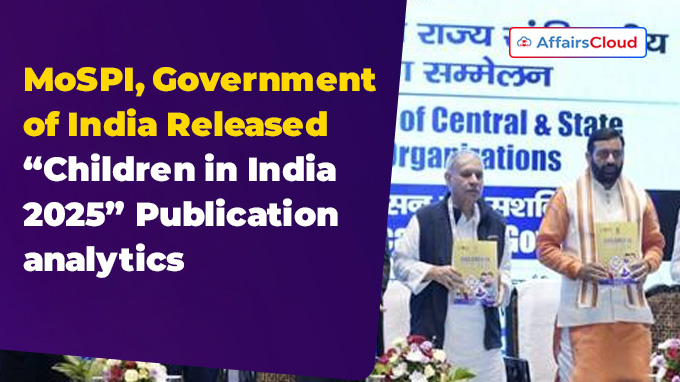In September 2025, the Ministry of Statistics and Programme Implementation (MoSPI), Government of India (GoI) released the 4th edition of the publication titled ‘Children in India 2025’ during the 29th Conference of Central and State Statistical Organizations (CoCSSO) in Union Territory (UT) Chandigarh.
- The latest publication provides comprehensive insights of the well-being of children in the country.
Exam Hints:
- What? Release of ‘Children in India 2025’ Report
- Edition: 4th
- Published by: MoSPI
- Released during? 29th CoCSSO
- Where? UT Chandigarh
- Key Population Indicators: Birth rate (18.4), U5MR (29), IMR (25)
- Rate of Child Marriage Declines to: 23.3 (in 2019-21)
- Literacy Rates among Children & Adolescents: 63.1%
About Children in India Report:
Annual Publication: Since 2008, MoSPI has been publishing an ad-hoc publication titled ‘Children in India’.
Key Chapters: The latest report is comprised of 7 chapters namely, overview; population and vital statistics; health & nutrition; education & development; crimes involving children and child protection; policy & legal framework and Sustainable Development Goals (SDGs) related to children.
Key Changes: The report introduced various changes like: an expert committee comprising representatives from the Ministries/Departments and domain experts in the field of demography was formed to consult on potential improvements.
- The report has also introduced various new indicators such as: ‘Causes of Death’, ‘Adoption Statistics’, ‘Overall Performance Comparison’, and ‘Usage of Mobile and Other Devices’.
Key Findings:
Health & Population:
IMR: The Infant Mortality Rate (IMR) has sharply decreased from 44 deaths per 1,000 live births in 2011 to 25 in 2023.
- While, IMR for Males and Females in 2023 stood at 25 and 26, respectively.
- Among all Indian states, In 2023, Chhattisgarh and Madhya Pradesh (MP) registered the highest IMR at 37, while Kerala recorded the lowest IMR at 5.
U5MR: According to the Sample Registration System (SRS)-Statistical Report 2023, Overall India’s Under-5 Mortality Rate (U5MR) is estimated at 29 (in 2023), compared to 30 (in 2022).
- However, U5MR differs from rural areas (33) and urban areas (20) of the country in 2023.
- MP reported the highest U5MR at 44; followed by Uttar Pradesh (UP) (42) and Chhattisgarh (41). Kerala reported the lowest U5MR i.e. 8 deaths per 1,000 live births.
Birth Rate: As per SRS data released by the Office of the Registrar General of India (O/o RGI) under the Ministry of Home Affairs (MHA), India’s birth rate has decreased from 19.1 (in 2022) to 18.4 per 1,000 population (in 2023).
- The data further showed rural birth rate stood at 20.3 (in 2023), which is higher than urban birth rate of 14.9 (in 2023).
- Bihar reported the highest birth rate i.e. at 25.8 in 2023; while, UT Andaman & Nicobar Islands recorded the lowest birth rate i.e. at 10.1.
Early Neo-natal Death: At national level, nearly half of all newborn deaths (about 48%) reported during the 1st 29 days after birth are linked to premature birth or low weight at birth.
- It is followed by birth asphyxia and trauma during birth (16%), and pneumonia (9%).
Women:
Decline in Child Marriage: The report showed that the percentage of women aged 20-24 years who had married before the age of 18 years has declined to 23.3 (in 2019-21) against 26.8 (in 2015-16).
Education:
Dropout Rate: As per the Unified District Information System for Education Plus (UDISE+) data for 2024-25, released by the Department of School Education & Literacy (DoSEL), Ministry of Education (MoE), the dropout rate for academic year 2024-25 has improved significantly across 3 educational levels (Preparatory, Middle and Secondary) as compared to previous two academic years (2023-24 and 2022-23).
- At the preparatory level, the total dropout rate declined significantly from 8.7% to 2.3% (in 2024-25).
- Similarly dropout rate at Middle level and at Secondary level decreased to 3.5% and 8.2%, respectively.
Gender Parity Index (GPI): At the national level, GPI data for 2024-25 is achieved across 3 educational levels with GPI for secondary level is the highest at 1.1.
Child Adoptions in India:
Increase in Adoptions: As per the report, the total number of children adopted increased from 3,927 (in 2017-18) to 4,515 (in 2024-25).
Inter-country and In-country Adoptions: The report further showed that the number of in-country adoption has ranged between 2,991-4,144 children annually.
- While, the inter-country adoptions have ranged between 360-653 children annually.
Gender Preference: Out of 4,155 in-country adoptions during 2024-25, 2,336 were female children and 1,819 were male children. This figure indicates gender preference as female children were adopted more than male children in in-country as well as inter-country adoptions.
Adolescent Health & Literacy Findings
Hypertension Among Teens: The report identified a concerning national average of 5% of Indian teenagers with hypertension. Delhi reporting the highest prevalence at 10%, followed by UP (8.6%), Manipur (8.3%), and Chhattisgarh (7%).
Literacy Rates: The data notes a high level of literacy among Indian children and adolescents, with a national average of 63.1%.
Important Terms:
Birth Rate: The number of live births per 1,000 people in a population during a specific year.
Infant Mortality Rate (IMR): The number of deaths of children under one year of age per 1,000 live births.
Neo-natal Mortality Rate: It is defined as the number of infant deaths less than 29 days of life per 1,000 live births.
Early Neo-natal Mortality Rate: It is defined as the number of infant deaths less than 7 days of life per 1,000 live births.
About Ministry of Statistics and Programme Implementaion (MoSPI):
Minister of State (MoS)(Independent Charge, IC) – Rao Inderjit Singh (Constituency- Gurugram, Haryana)




